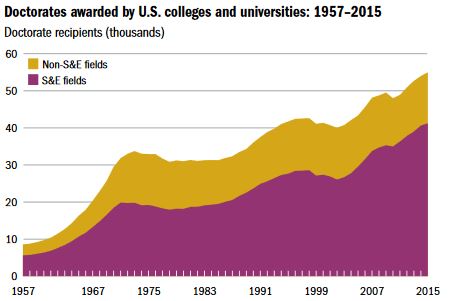
According to a new report, U.S. institutions awarded the most doctorates ever recorded in 2015. [Image: National Science Foundation]
According to a report from the U.S. National Science Foundation (NSF), 2015 was a record-breaking year for U.S. research doctorates, with 55,006 degrees awarded by U.S. academic institutions—nearly 67 percent above the level 40 years earlier. And, in a particularly striking finding, virtually all of the growth since 1975 has been in doctorates in science and engineering (S&E).
Annual census
The recent study is the latest entry in an annual census, the Survey of Earned Doctorates, sponsored by NSF and five other U.S. government agencies and published by NSF’s National Center for Science and Engineering Statistics. Conducted since 1957—when a mere 8,611 research doctorates were recorded—the survey has since evolved into an instrument tracking a variety of demographic and disciplinary variables in U.S. doctoral education. The report's ultimate goal is to assist policymakers in making “informed improvements” in the doctoral-education system.
One arresting theme of the report is the dominance of S&E degrees in the growth of doctoral education. The report’s data suggest that, since 1975, the needle has barely moved on non-S&E doctorates: Some 13,745 non-S&E doctorates were minted in 2015, versus 13,742 forty years earlier. In the same timeframe, S&E doctorates more than doubled, from 19,210 in 1975 to 41,261 in 2015.
Welcoming a new guard
The report also documented the changing demographics of degree recipients—a reflection, according to the report, of “political, economic, social, technological, and demographic trends and events” in modern U.S. society.
The report notes, for example, that in 2015, women earned a majority of doctorates awarded to U.S. citizens and permanent residents, continuing a pattern that has existed since 2002. Women have made rapid gains in the number of research doctorates granted in S&E fields across the board since the early 2000s.
Within specific S&E disciplines, however, the gender pattern remains decidedly mixed. By 2015, women were earning a majority of graduate degrees in life sciences, psychology/social sciences, and education, humanities/arts and other non-S&T fields. Yet women earned only a third of 2015 U.S. doctorates in physical and earth sciences, a quarter of math and computer science degrees, and less than a quarter of engineering degrees.
There were some signs of upward momentum even in these areas, however. From 2005 to 2015, for example, the proportion of doctorates received by women in engineering grew five percentage points, thanks to large relative growth in bio- and biomedical engineering. The proportion of female doctoral recipients in physical and earth sciences grew slightly more, by six percentage points, over the same period. (By contrast, the percentage of women receiving doctorates in math and computer science was virtually flat between 2005 and 2015, according to the study.)
As with women—and likely in response to a similar blend of socioeconomic factors and demographic trends—minority/historically underrepresented populations have experienced some gains, albeit modest, over the last decade. The percentage of African Americans receiving research doctorates edged up from 6.2 percent to 6.5 percent between 2005 and 2015, while, during that same decade, Hispanics or Latinos percentage grew from 5.1 percent to 7 percent. These numbers, however, remain substantially below the proportion of African Americans (13.2 percent) and Latinos (17 percent) in the general U.S. population.
Immigration's impact
In 2015, the controversial efforts by the Trump administration to impose restrictions on immigration from certain countries had not yet come to bear in the U.S. S&E doctorates granted to temporary-visa holders in 2015 rose 2 percent year to year a whopping 30 percent from 2005 levels.
From 2011 to 2015, 86 percent of the doctorates earned by temporary-visa holders were in S&E fields. Many of the temporary-visa holders hailed from Asia and the Asian subcontinent. China, India and South Korea, in particular, accounted for over half of the temporary-visa holders receiving doctorates from U.S. institutions.
The economic impact
The authors of the study took pains to tie the study to large economic and national-interest dimensions. Noting that the U.S. doctoral-education system is “widely considered to be among the world’s best”—a perception implicit, according to the report, in its ability to attract students from other countries—continuing that pre-eminence is “not assured.” And, as other societies invest in their own graduate education systems, there’s the risk, according to the report, that “the world’s brightest students” may increasingly study and start careers elsewhere.
“Doctorate recipients begin careers in large and small organizations, teach in universities, and start new businesses,” the report observes. “Doctoral education develops human resources that are critical to a nation's progress … In doing so, they contribute to a nation's economic growth, cultural development, and rising standard of living.”
The study, including an unusually interesting and well-organized data set, can be found at www.nsf.gov/statistics/sed/.
